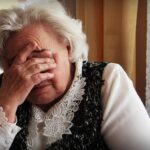A full 47 million households with older adults are financially struggling today or are at risk of falling into economic insecurity as they age, according to new research by the National Council on Aging (NCOA) and the LeadingAge LTSS Center @UMass Boston.

Sad Older Woman
Researchers analyzed data from 2016 and 2018 to determine the true scope of economic insecurity in later life. The latest data finds that 80% of households with older adults either cannot afford their basic and long-term care needs today or are at risk of not being able to do so in the future. It also finds that older households in the top 20% experienced much larger gains in net wealth in two years than their less-wealthy counterparts.
“The gap between the haves and the have-nots appears to be widening,” said Dr. Susan Silberman, NCOA Senior Director, Research & Evaluation. “This research supports the need to invest in programs and solutions that enable every person to maximize their health and financial security as they age.”
Researchers defined a household as financially secure if their total net wealth could cover the costs of housing, food, other necessities, and long-term care, if needed. “At risk” households were defined as those with some savings and assets to potentially meet current needs, but not enough to cover a financial shock.
The likelihood of experiencing a financial shock is high as people grow older. Over a nine-year period, more than two-thirds of adults aged 70 and older will experience at least one negative shock with financial consequences, such as falling into poor health, becoming widowed, or losing the ability to work or live independently. Article courtesy of National Council on Aging.
